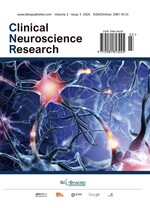Abstract
Objective: To develop a sensitive and reliable diagnostic approach for optic neuromyelitis (ONM), an overexpressing cell line capable of detecting aquaporin 4 (AQP4) antibodies was established. Subsequently, immunofluorescence was employed to detect AQP4 antibodies in serum and cerebrospinal fluid (CSF) samples from patients. Additionally, the clinical utility of AQP4 antibodies in the detection of ONM patients was analyzed. Methods: An aquaporin 4 expression plasmid was constructed and transfected into cell lines. Subsequently, indirect immunofluorescence was utilized to detect anti-AQP4 antibodies in serum and cerebrospinal fluid samples. Results: The indirect immunofluorescence detection system exhibited high sensitivity in the detection of 2241 clinical samples, with a positive rate of 16.8%. The positive proportion was in line with epidemiological data, and the positive situation was consistent with clinical symptoms. Conclusion: The engineered cell line exhibits superior detection performance for identifying antibodies present in serum and cerebrospinal fluid samples. The capability to detect anti-aquaporin 4 antibodies is pivotal for improving the efficiency of screening and diagnosing neuromyelitis optica, thereby possessing considerable potential for clinical application.
References
Lennon VA, Wingerchuk DM, Kryzer TJ, et al., 2004, A Serum Autoantibody Marker of Neuromyelitis Optica: Distinction from Multiple Sclerosis. The Lancet, 364(9451): 2106–2112.
Neuroimmunology Branch of Chinese Society for Immunology, 2021, Guidelines for the Diagnosis and Treatment of Neuromyelitis Optica Spectrum Disorders 2021 Edition. Chinese Journal of Neuroimmunology and Neurology, 28(6): 423–436.
Zhou H, Yang H, 2013, Antibodies Related to Central Nervous System Autoimmune Diseases. Journal of International Neurology and Neurosurgery, 40(3): 289–293.
Jung JS, Bhat RV, Preston GM, et al., 1994, Molecular Characterization of an Aquaporin cDNA from Brain: Candidate Osmoreceptor and Regulator of Water Balance. Proceedings of the National Academy of Sciences of The United States of America, 91(26): 13052–13056.
Papadopoulos MC, Verkman AS, 2012, Aquaporin4 and Neuromyelitis Optica. The Lancet Neurology, 11(6): 535–544.
Verkman AS, Phuan PW, Asavapanumas N, et al., 2013, Biology of AQP4 and Anti-AQP4 Antibody: Therapeutic Implications for NMO. Brain Pathology, 23(6): 684–695.
Matiello M, Schaefer-Klein J, Sun D, et al., 2013, Aquaporin 4 Expression and Tissue Susceptibility to Neuromyelitis Optica. JAMA Neurology, 70(9): 1118–1125.
Li M, Qin XY, 2015, Clinical Application of Multiple Methods to Detect Aquaporin-4 Antibody in Serum and Cerebrospinal Fluid of Patients with Neuromyelitis Optica. Laboratory Diagnostics in China, 19(8): 1261–1263.
